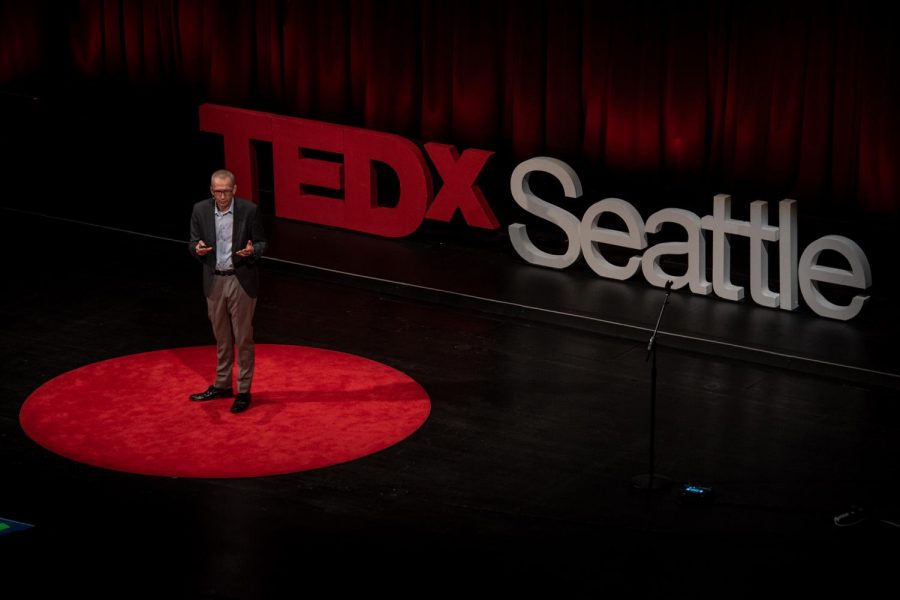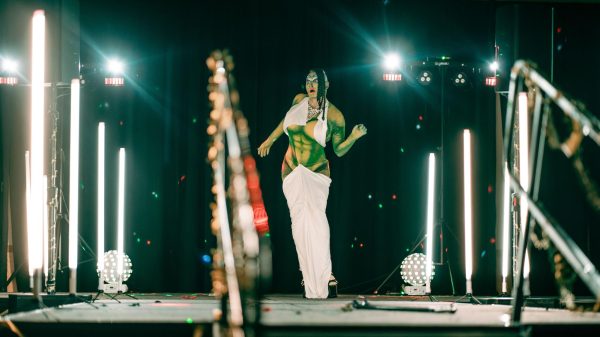Shifting Attitudes at 10th Anniversary of TEDxSeattle
TEDxSeattle held their 10th anniversary event at McCaw Hall on Saturday, Nov. 22, a theatre that is home to the Nutcracker and the Seattle Opera. The theme of this year’s talks was “SHIFT,” with multiple speakers from a wide range of disciplines, such as art, medical research and technology—talking about how these contribute to shifts in attitudes to major changes in societies.
At the entrance, the Iconic red “X” was displayed outside with a huge line to take photos with. The venue was decorated with large red banners that showcased the cartoon-drawn pictures of the speakers I would hear that day. I walked in and received a huge badge that read my name in large purple letters accompanied by “Students of the World.” I like that touch a lot.
The dim stage, the shining spotlight and the speaker standing confidently on a red circle in front of the iconic “TEDx” sign—they are composed when they speak on that red circle, holding our attention and guiding us through a journey for the 12- 15 minutes they are on that stage.
Even when I would watch videos of TED Talks from my computer screen at home, I was always so entranced with the mighty knowledge that those speakers had. I had always imagined what it would be like to sit in the audience and be surrounded by a community of forward-thinking people, all just trying to learn more about the world around us.
One of the most shifting speakers was Sam Shahar. Shahar, who is a professor of anesthesiology and pain medicine at the University of Washington, spoke about pain and virtual reality. He said that “pain is mental” and that providing burn victims with a reality that is calming— when enduring treatment—can replace the need for prescription drugs.
Shahar showed several brain scans of patients going through a treatment with and without a virtual reality headset. The scans showed that patients actually had a decrease of pain at about 40% and experienced three times as much enjoyment. Scans showed that virtual reality affects the brain exactly the same as if the patient were on opiods. If virtual reality was used on top of a dosage of opioids, the scan revealed that the patient was experiencing no pain whatsoever. His talk was filled with extensive research that was easy to understand and digest, coming from someone who did not know anything medical related.
Following Shahar was Karen Okonkwo—and let me tell you, she is a complete boss. Her talk was filled with drama, humor and progressiveness. She talked about being in a sorority and running a blog that was about Greek life. When one of her friends confronted her that her blog did not feature any people of color, she was beside herself.
Okonkwo spoke to her experiences as a black woman, and how she grew up only seeing white, heterosexual faces in advertising. She displayed a couple of Google searches that contained the words sorority, couple and business on a screen above her. Through research, she found that the reason for this was because there was no diversity in stock photos.
To combat this, Okonkwo started her own diverse stock photo company called TONL. They combat the out- dated view of indigenous people by showing photos of them at home with their families. TONL featured a shoot with an African-American male at the head of a table combatting the stereotypes of absent black fathers. Her work puts a stop to white washing in advertising, by that, she is changing stigmas of people of color.
All the talks here today lived up to the theme “SHIFT.” They weren’t just a knock asking us if we could listen, they were the breaking of a door. They were the breaking of social barriers demanding us to listen and acknowledge these issues in society.
The editor may be reached at [email protected]










